In this article, I show you how easy it is to grow grass trees from seed, how to identify grass tree species, and where to see them in nature in Australia.
Grass trees are unique to Australia and have a quite special role in the ecosystem. Apart from being quite unusual plants that stand out, grass trees also have a very large flowering spike that can be more than two metres tall.
This also makes them quite desirable as garden plants.
Their flowers are rich in nectar and very attractive to nectar-loving birds and insects such as honey-eaters and butterflies. In addition, they have large seed that are a favourite of seed-eating birds such as parrots.
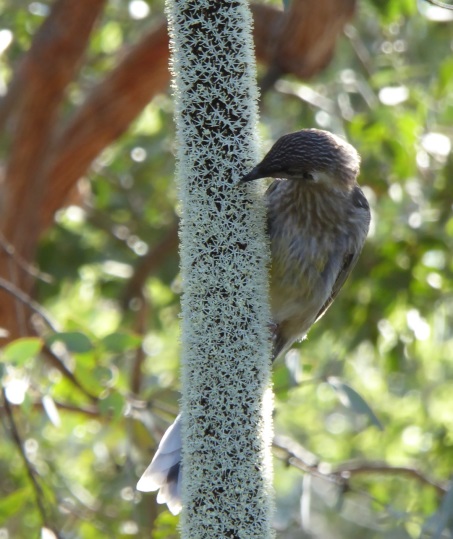
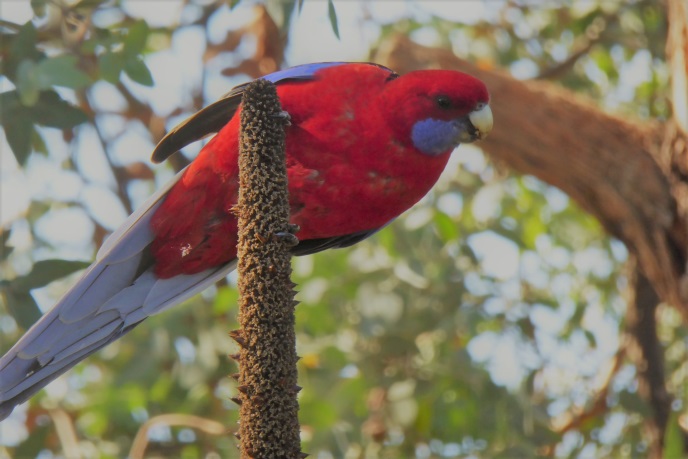
QUICK LINKS
How to grow grass trees from seed (Xanthorrhoea)
Grass trees are neither grasses nor trees, so their common name is quite misleading. This is why I prefer to use the botanical name Xanthorroea. This is the botanical name of the genus, which contains about 30 species.
In nature, grass trees are slow growing, but also get very old (350 to 450 years). However, it is very hard to transplant a grass tree from the bush, as they have unique symbiotic mycorrhizal fungi. Root disturbance upsets this symbiotic arrangement. This is the reason why grass trees transplanted from the bush often die a slow death.
For gardeners, grass trees are very desirable plants:
- They are graceful feature plants for the garden, well-suited for wild gardens as well as formal gardens.
- Their leafy crowns offer protection to many local insects and animals, while their flowers and seeds attract birds and butterflies.
- They are drought hardy and do not require special care.
What is more, you can easily grow grass trees from seed. When you plant them in the garden from seedling, you will be part of their evolution and meet all wildlife they attract.
A naturally occurring local species will be best suited to your local climate (see below).
I can personally testify that you can grow a nice dense crown of grassy leaves that looks great in the garden in about 5–10 years (see below). A trunk takes many more years to develop (20+).
Collecting the seed
Many nurseries sell seed of popular Xanthorrhoea species; however, try to pick a species that is local to your area (see below). If you are lucky enough to have a plant in the garden or in a friend’s garden, try to collect the seed after it has matured on the flowering spike.
Seed develops in capsules on the flowering spike in the months after flowering. As they mature and grow, these capsules start to stick out from the surface of the spike and are easily visible. When the capsules open, this means the seed is ready for picking.
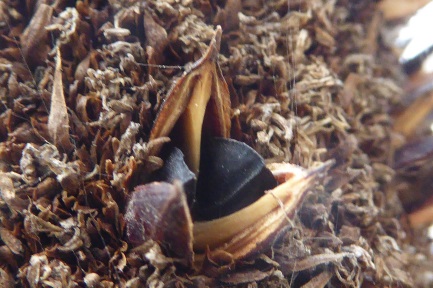
Depending on the species, there are usually 2 to 3 seeds per capsule. I usually leave most of the seed for the birds and wait until the spike naturally breaks off before collecting seed for myself.
There is usually plenty of seed left on the spike, as the seeds fit quite tightly in the capsule on the spike. You can prise the seeds out with tweezers or just tap the whole spike on a newspaper or plastic sheet until the seeds drop out.
Sowing the seed
The seeds are quite large (more than 5 mm long) and easy to handle.
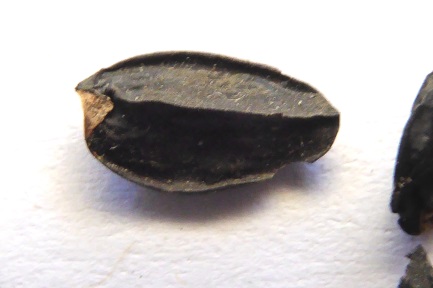
Seeds can be sown all year round, but spring or autumn is best, as these months have less extreme temperatures for germination. The seeds germinate well without special treatment, but not all seeds will be viable. Therefore, I have started to sow many seeds to a punnet and then pot up those that germinate when very young.
To sow:
- Fill a seed tray with potting mix mixed with some sand to improve drainage.
- Compress the mix and moisten.
- Place the seeds flat (with widest part) on the surface.
- Cover with a thin layer of soil (2–3 mm).
- Water the seed tray again with a fine mist spray to ensure the seeds are not washed out.
- Place the seed tray inside a transparent plastic take-away container and close the lid tightly. This will ensure moisture levels stay constant inside the container.
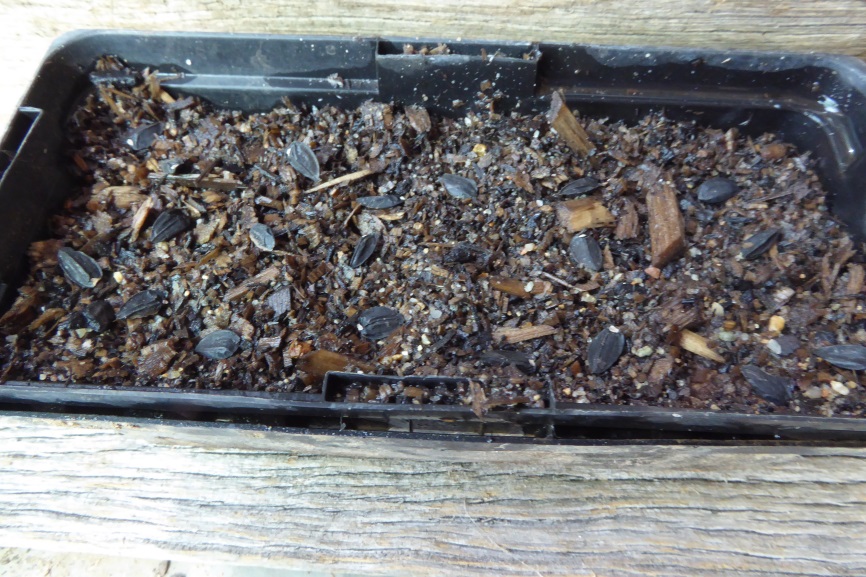
To ensure germination:
- Place the seed tray in a warm (18–22°C) place in the shade and close the lid.
- Check the seed tray regularly and add moisture if it looks like it is drying out.
Germination can occur after 4 to 6 weeks, but can take as long as 52 weeks in some species.

About 60 days after growing grass trees from seed, I had 6 seedlings (a success rate of 1/3).
After germination:
- Let the seedlings grow until they touch the lid of the take-away container.
- Prick out the seedlings from the seedling tray, making sure not to damage the young root.
- Plant each seedling in its own root-training pot using a well-draining potting mix.
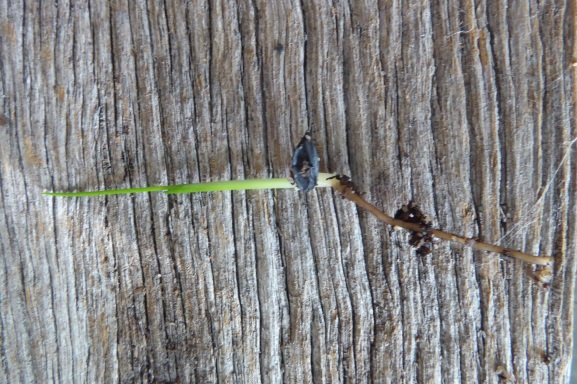
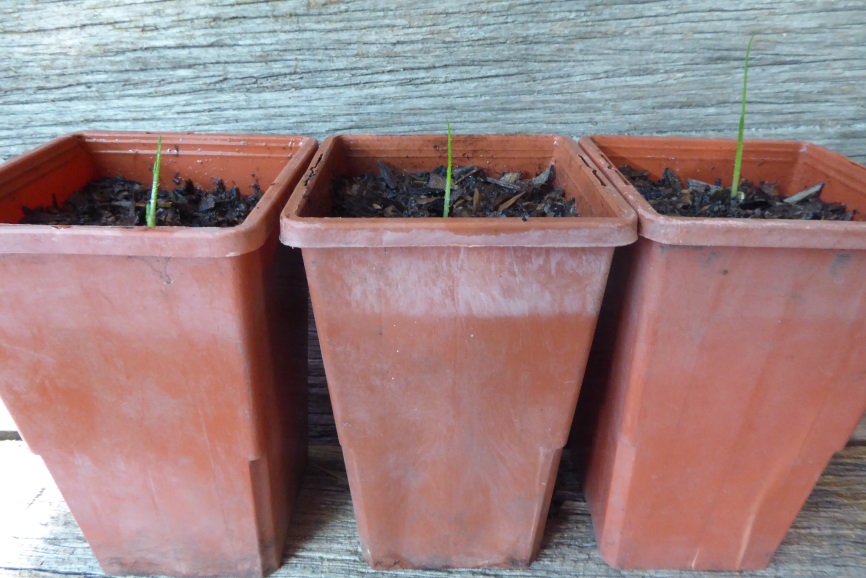
After potting up:
- Grow the seedlings in pots in semi-shade for about 12 months.
- Water the pots daily with a mist spray.
- Check regularly if roots protrude from the bottom of the container.
- When several roots start protruding from the bottom of the pot, carefully slip it out of the pot and do a root ball check.
- If the root ball is well developed, wait until early spring or early autumn to plant the seedling in the garden. If it is not well developed, keep the seedling in the pot and repeat the check after a few months.
Planning and preparation
Grass trees grow slowly, but dislike being transplanted, so it is important to plan your garden design and plant them in their final spot in the garden.
Find a suitable spot in the garden that has full sun and good drainage. If your soil is clay or loam and does not drain well, create a small mound in which to plant. This will improve drainage. You can also mix some sand in the mounted soil before planting.
As the plants will remain small and not very visible for a number of years, you will have to make sure you do not accidentally step on them! So, plan to add something to remind you they are there. For example, you can plant them among small colourful plants that will not push them aside or interfere with their root system (e.g. local native perennial daisies) while they grow. You could also surround them with rocks so they are more visible in the garden.
When growing grass trees from seed, you are starting on a long but exciting journey. Over the years you will become quite wrapped and involved. What is first a small tuft of leaves, slowly grows larger and larger. Then, the plants turn into large spheres of leafy crowns and become visible and special. Next, they push up a giant spike and become a dominant part of the garden! I have now had several of these spikes, and have noticed that some of the grass trees are starting to split their crowns into double crowns. It is an ever evolving journey…
Planting
When you have found a suitable spot and are ready for planting:
- Do a final root ball check.
- Wait until early spring or mid-autumn when the temperatures are mild.
- Find a suitable spot in the garden in full sun and with good drainage (not in a place where water runoff collects).
- Dig a large hole, at three or four times as wide, and at least twice as deep, as the plant pot.
- Water the hole and wait until it drains.
- Carefully remove the plant from its pot and do not disturb the roots.
- Mix some compost and slow-release fertiliser for natives into the soil you removed from the hole.
- Place the plant in the middle of the hole, and fill the remaining space with the soil mix you just prepared.
- Water the plant and surrounding mix well.
- After a few days, water again with a water and seaweed solution.
- Water every few days in hot weather, every week in cool weather for the first month(s) as needed (do not water if the soil is still wet from previous watering or rain).
- Once you notice new leaves growing, reduce this regular watering regime and only water in hot or very hot weather until the plant is established and growing well.
Follow-up after planting
Grass trees do not need much maintenance, but need to be looked after in the first few years because they are so inconspicuous in the garden. Don’t trample them!
To look after your young plants:
- Sprinkle a spoonful of slow-release fertiliser for native plants around the plant early each spring and autumn.
- Water weekly until the plant is well established (in dry areas this may be for up to a year if there is little rain).
- Once the plant is well established, it is very drought hardy and only needs watering on very hot days.
Grass trees form a symbiotic relationship in the soil with mycorrhizal fungi through their root system. These fungi are beneficial to the plants and help them take up nutrients. A tip from ABC’s Gardening Australia recommends adding a cup of brown sugar to a can of water when watering, as this will feed the mycorrhizal fungi in the soil. I have not yet tried this.
Plant growth
Your patience will be rewarded as you follow the plant’s growth over the years. I have plants of various ages in the garden and I keep adding more. This means I can show you plants at various stages in their life.
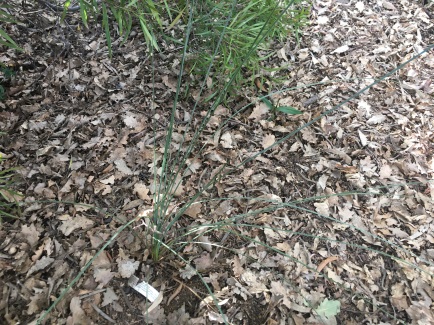
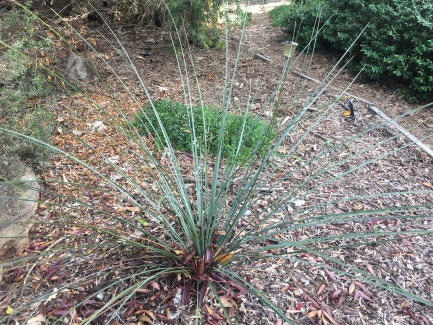
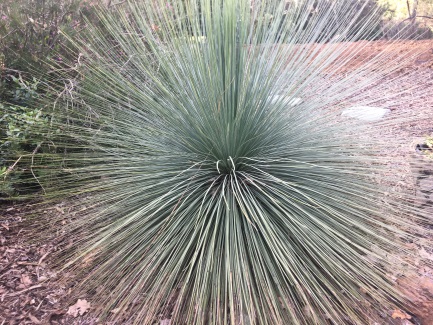
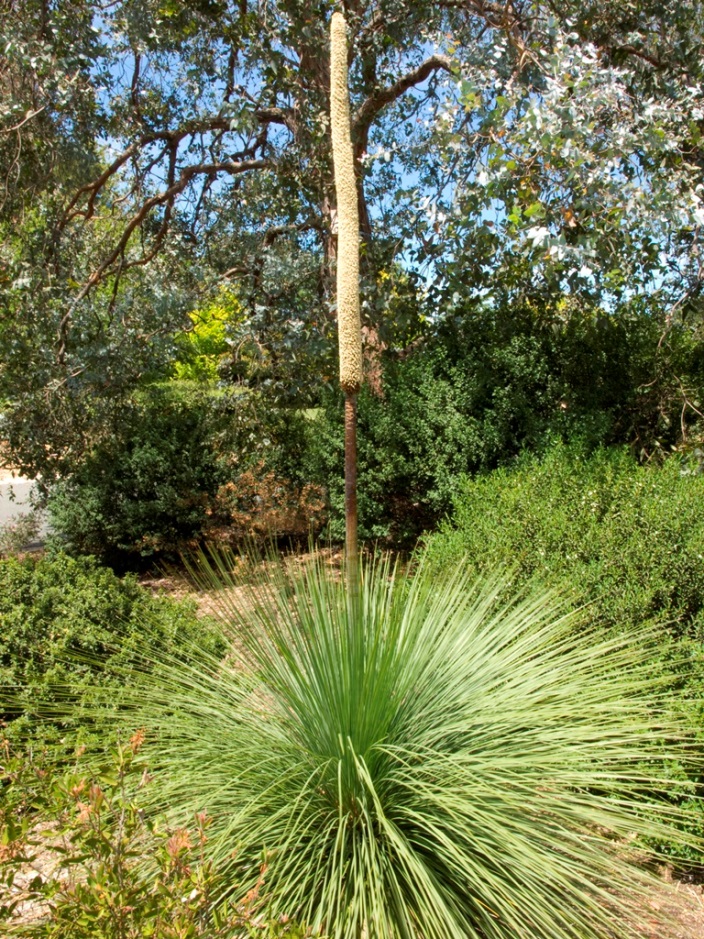
Did you know?
- Grass trees belong to the plant genus Xanthorrhoea, which is a member of the Xanthorrhoeaceae).
- The genus Xanthorrhoea, is Endemic to Australia.
How to identify your local grass trees
The botanical name for the Grass Tree genus is Xanthorrhoea. This word is derived from the ancient Greek word xanthos, which means yellow, and rhoea, which means flowing. This ‘yellow flow’ refers to the yellow gum or resin that flows from the leaf bases in the type species, Xanthorrhoea resinosa. This resin has had multiple uses (see below).
To identify a grass tree, you need to first make yourself familiar with the botanical characteristics—and their terminology—that are common to all species. The following characteristics apply to all species of Xanthorrhoea.
Habit
All Xanthorrhoea species are woody-stemmed perennials with long, linear leaves that are crowded at the end of the stem. As they grow, many species (but not all) develop a tree-like stem, that is packed densely with old leaf bases. Some species have branched stems, each with a crown of terminal leaves. Those species that do not develop a tree-like habit have a stem that remains underground.
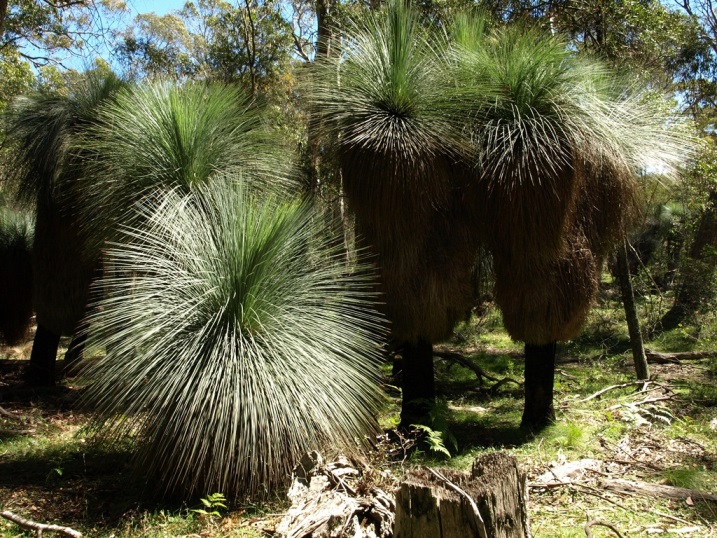
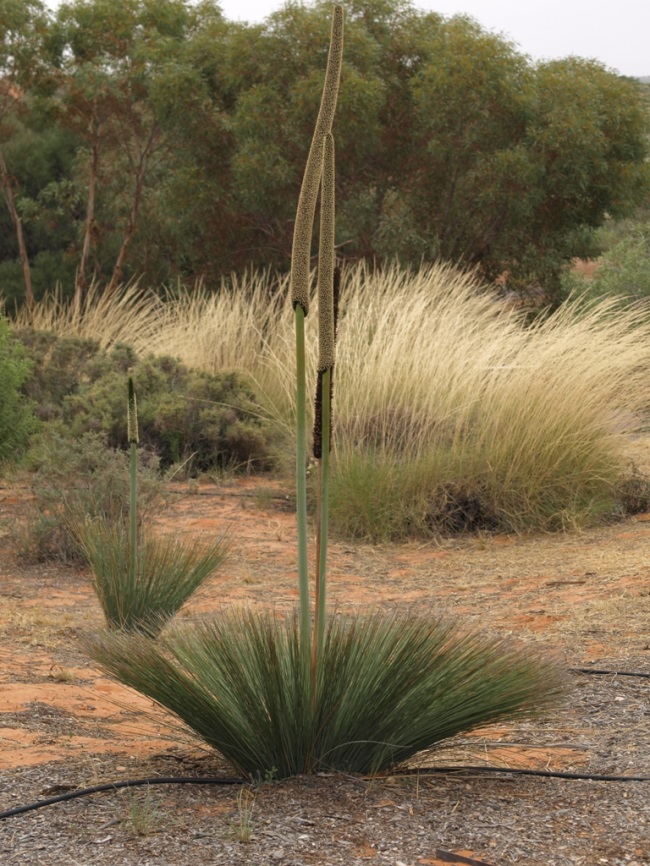
Roots
The root system is quite sensitive and has a unique symbiotic relationship with mycorrhizal fungi. This is the reason why the plants dislike root disturbance and are very hard to transplant when mature.
Leaves
The long, linear leaves have a broad leaf base and a tapered end. The leaf cross-section (varying from Rhombic to Cuneate) at about the middle of the leaf length is sometimes used as one of the characteristics to distinguish species (see below).
Grass tree leaves are very tightly packed on the stem, which helps protect the plant during fires.
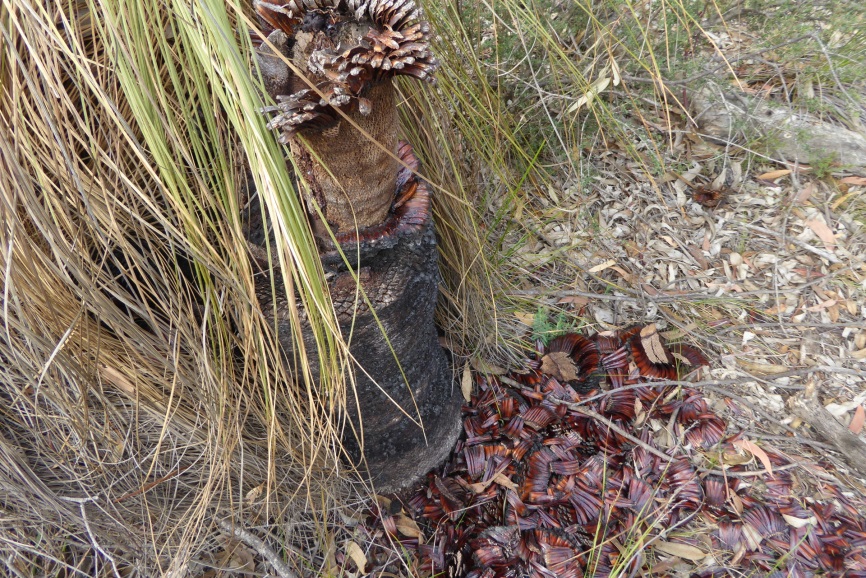
Flowers
When flowering, a large cylindrical spike-like inflorescence grows from near the centre of the plant’s growing tip on a woody scape. As Robert commented [see below], this spike can grow quite fast: up to 40 mm per day.
The small flowers are bisexual and densely packed in clusters arranged in spirals on the top half or third of the scape. The flower clusters have cluster-bracts below them, and the flowers in the clusters are surrounded by small packing bracts. The characteristics of these two types of bracts are important for the identification of some species.
The flowers are strongly scented and produce sweet nectar that is loved by birds and insects. The flower perianth consists of six free segments in two whorls of three. The inner three segments are yellow to white, while the outer three are paper-like.
The stamens develop first and have flattened filaments and anthers that open by slits. The style is short at the start of flowering, but elongates as the anthers age. The ovary is 3-locular and each locule can have several ovules. There is a simple style.
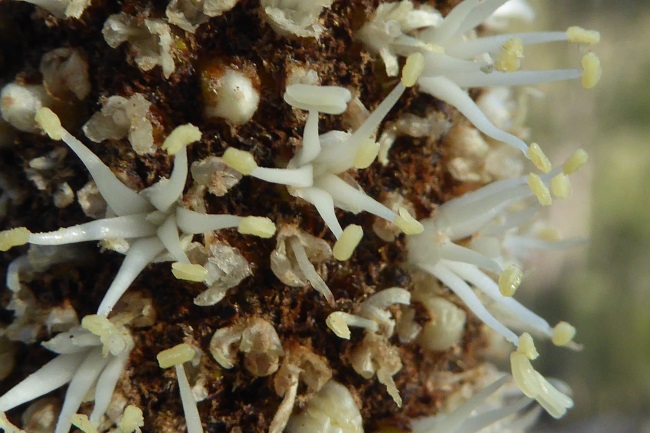
Fruit and seeds
The fruit is a capsule, that has an obtuse to pointed tip, and 1 or 2 seeds per locule. The seeds are mostly ovate and semi-matt black.
After flowering, the developing fruit capsules start to protrude from the surrounding persistent perianth and packing bracts on the spike. Each capsule eventually splits open to show black seeds inside.
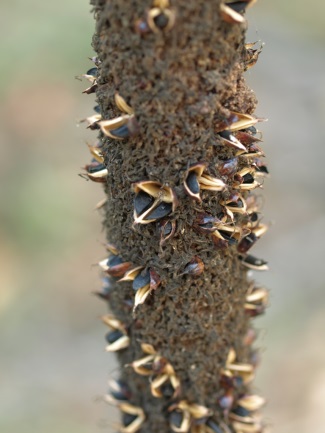
Species variation and identification
Grass trees can rarely be identified on one or two characters alone; usually a combination of many characters is required for critical determination. This means that locality is often a useful aid to identification, as not all species occur in all regions.
In the Flora of Australia, the characteristics that are useful for identification include: transverse section of the leaf at mid-length; trunk height; the ratio of the length of the scape to the length of the flowering spike; the scape diameter just below the flowering spike; and leaf colour.
The shape of the two types of bracts on the flowering spike is also used to distinguish some species from each other. When using this characteristic, only measure the largest of the bracts.
Link to the identification key to all species in Australia: Keybase, Flora of Australia
The above key is an identification key to all species in Australia. However, as not all species occur together, it is much easier to use a regional key.
In the next section, I list species by state and provide links to shorter regional identification keys for each state.
Species of grass trees in Australia
Australian distribution
Species of this genus occur in each state, but they are most abundant in a wide band along the east and south coastal areas of Australia.
The Atlas of Australian Wildlife distribution map below illustrates this.
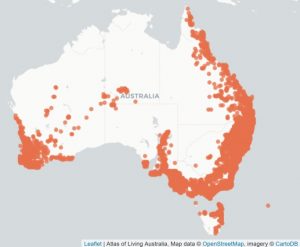
ACT
- Xanthorrhoea glauca D.J.Bedford (Xanthorrhoea glauca subsp. angustifolia)
Link to species identification key for ACT: Plantnet
NSW
- Xanthorrhoea acaulis
- Xanthorrhoea arborea
- Xanthorrhoea australis
- Xanthorrhoea concava
- Xanthorrhoea fulva
- Xanthorrhoea glauca
- Xanthorrhoea johnsonii
- Xanthorrhoea latifolia
- Xanthorrhoea macronema
- Xanthorrhoea malacophylla
- Xanthorrhoea media
- Xanthorrhoea minor
- Xanthorrhoea resinosa
Link to species identification key for NSW: Plantnet
NT
- Xanthorrhoea thorntonii
Link to species description for NT: Wikipedia
Qld
- Xanthorrhoea arborea
- Xanthorrhoea australis
- Xanthorrhoea fulva
- Xanthorrhoea glauca
- Xanthorrhoea johnsonii
- Xanthorrhoea latifolia
- Xanthorrhoea macronema
- Xanthorrhoea malacophylla
- Xanthorrhoea media
- Xanthorrhoea pumilio
- Xanthorrhoea sp. Cape Bedford
Link to species identification key for Qld: Keybase, Flowering Plants of Queensland
SA
- Xanthorrhoea australis
- Xanthorrhoea quadrangulata
- Xanthorrhoea semiplana
Link to species identification key for SA: eFlora of South Australia
Tas
- Xanthorrhoea arenaria
- Xanthorrhoea australis
- Xanthorrhoea bracteata
Link to species identification key for Tas: Keybase, Flowering plants of Tasmania
Vic
- Xanthorrhaea minor
- Xanthorrhoea australis
- Xanthorrhoea caespitosa
- Xanthorrhoea minor
- Xanthorrhoea resinosa
- Xanthorrhoea semiplana
Link to species identification key for Vic: Flora of Victoria online
WA
- Xanthorrhoea acanthostachya
- Xanthorrhoea brevistyla
- Xanthorrhoea brunonis
- Xanthorrhoea drummondii
- Xanthorrhoea glauca
- Xanthorrhoea gracilis
- Xanthorrhoea nana
- Xanthorrhoea platyphylla
- Xanthorrhoea preissii
- Xanthorrhoea sp. Lesueur
- Xanthorrhoea thorntonii
Link to species identification key link for WA: Florabase website
Where to see grass trees in Australia
Grass trees occur around Australia, but are most common in the east, south and southwest (see above). They are less common in central and northern Australia. Most species occur where rainfall is more than 250 mm a year.
Here are some places I have found where you can see grass trees, organised by state:
- Australian Capital Territory—Tidbinbilla National Park; Namadgi; Australian National Botanic Gardens
- New South Wales—Mount Annan Botanic Gardens; Dharug National Park, Grass Tree Circuit; Royal National Park, at the junction of Curra Moors Track and the Garie Headland Track; Livingstone National Park, Grass Tree Trail; Coolah Tops National Park; Lane Cove National Park, Great North Walk
- Northern Territory—Tnorala (Gosse Bluff) Conservation Reserve
- Queensland—Bunya Mountains National Park; Mt Chinghee National Park; Springbrook National Park; Main Range Nationals park; Lamington National Park
- South Australia—Arkaroola, Arid Lands Botanic Gardens
- Tasmania—Friendly Beaches Reserve; Narawntapu National Park; Freycinet National Park
- Victoria—Cranbourne Botanic Gardens; Royal Botanic Gardens, Melbourne; Brisbane Ranges National Park, Burchell Trail; Grampians National park, Little Desert; Gellions Run; Warby-Ovens National Park
- Western Australia—Kings Park and Botanic Garden, Perth; Cape Arid National Park; Lesueur National Park; John Forrest National Park; Wannagarren Nature Reserve; Geraldton Sandplains/li>
There are of course many more places where you can see them.
Fire resistance
Xanthorrhoeas are resilient in fire. The fire will blacken their stems and burn off the leaves, but the leaves regrow after fire. The plants will often flower in the spring following the fire to encourage new seed production to replenish the seed bank in the soil.
Use and history of Xanthorrhoea
Aboriginal use
Aboriginal people found grass trees very useful plants and used many parts of it.
- Flowers—The flowers are rich in nectar and this was collected with a ‘sponge’ made of stringybark and used as a food source.
- Seeds—The seeds can be eaten and were ground to a flour.
- Flower spikes—The flower spike is usually very straight and made of soft, light wood. It was used to make spears and also as base for fire drills to make fire.
- Leaves—The bases of new leaves are soft and taste sweet and nutty. They were eaten. However, the tough leaves are so strong they were used as knives to cut meat.
- Insect larvae—‘Bardi grubs’ (beetle and moth larvae) can be found at the base of the plant and were a source of food.
- Resin—The leaf bases are packed tightly on the stem and secrete a strong, waterproof resin that holds the leaf bases tightly together. Over time, and especially as a result of fire, this resin collects at the base of the leaves on the trunk in small nodules. These nodules eventually drop to the ground. The resin nodules were used as an adhesive to fasten barbs in spears or stone axes to handles. Their waterproof characteristics also made them useful as a sealant for water containers. This meant that Xanthorrhoea resin was also a valuable trading item.
- Roots—The roots that surround the stem base of Xanthorrhoea australis arise from an underground stem which is seasonally surrounded by sweet, succulent roots that can be eaten.
Early explorers history
The early explorers and settlers learned from the aboriginal people and soon realised some of the potentials of grass trees. They learned to eat the centre of the leafy crown and to extract the resin.
The resin was most valuable as it could be used for many purposes, such as protection on furniture and floors, and as a coating on brass instruments. Its most unusual use was in gunpowder and explosives, as it contains a considerable amount of picric acid. This unfortunately meant that they killed many grass trees.
Naming history of Xanthorrhoea
In 1770, grass trees—these strange-looking plants!—were certainly noticed by the botanists travelling with Captain Cook on HMS Endeavour, Joseph Banks and Daniel Solander.
Dr Daniel Solander used the name Acoroides resinifera as a manuscript name as early as 1770. On the UK’s Natural History Museum website, there is one watercolour on paper by Sydney Parkinson from this voyage.
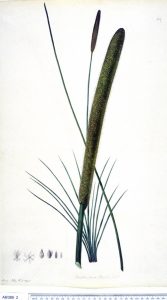
The manuscript name Acoroides resinifera was not known when the first fleet sailed to Australia in 1788 and for many years after.
According to the Australian Plant Name Index, Xanthorroea was named by J. E. Smith in 1798 (The Characters of Twenty New Genera of Plants. Transactions of the Linnean Society of London 4: 219). Smith did not cite specimens on which he based his description, but in 1818 he acknowledged he had received material from Dr John White. Thus, his description was likely based on this and possibly other material.
Dr John White was the surgeon on the Charlotte with the first fleet in 1788. He collected botanical and zoological material. In his journal ‘A Voyage to New South Wales’ about his travels, there is a colour plate that is clearly a drawing of a grass tree section. It is named the ‘Yellow Gum Tree’.
Dr White’s journal is a very interesting read and the 60 colour plates of plants and animals show how fascinated the explorers were with the new biodiversity discovered in Australia.
The State Library of New South Wales has among its images of the first fleet artwork collection two water colour drawings of a ‘Grass Tree’ or ‘Yellow Gum Tree’, citing ‘goo rung arra’ as the local native name.
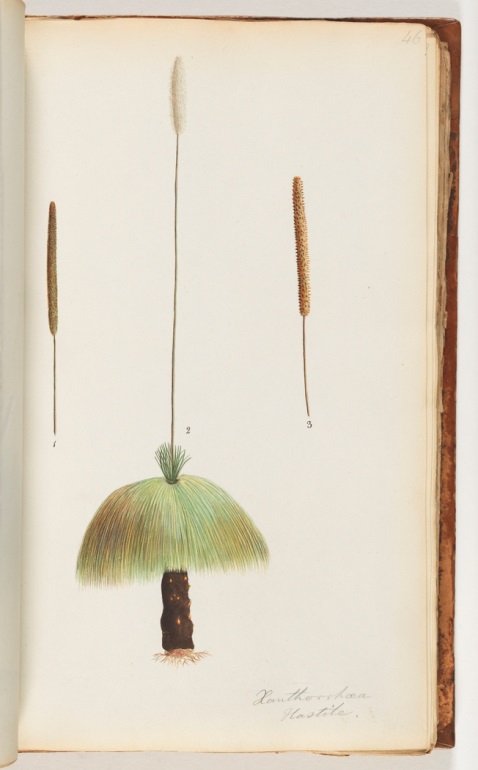
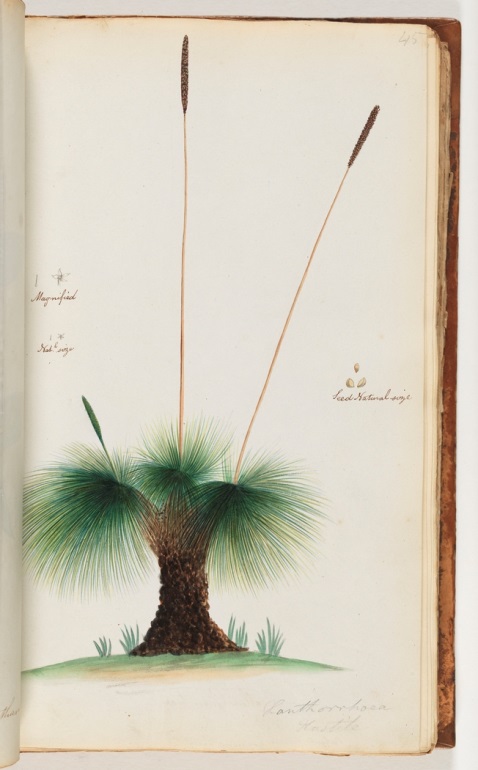
In 1992, Nelson proposed to retain the name Xanthorroea over the earlier published name Acoroides.
There are 30 species in the genus Xanthorrhoea. These are listed by state in the section above.
Sources and resources
On this site
To find more local plant books and web sites that can help you with identification, use the Plants in the top menu, and click on the link of your state.
Other gardening articles on this site:
External sources and resources on grass trees
- ABC, Gardening Australia website
- Atlas of Living Australia website, Xanthorrhoea
- Australian National Botanic Gardens website, Xanthorrhoea; Aboriginal trail
- Bedford, D. J. (1986). ‘Xanthorrhoea’, in: A. S. George, (Ed) Flora of Australia 46:148–169. ISBN 0-644-04356-3.
- Bush Heritage website
- Natural History Museum, the Endeavour botanical illustrations
- Nelson, E. C., and D. J. Bedford. (1059) Proposal to Conserve 1042 Xanthorrhoea J. E. Smith over Acoroides C. Kite (Xanthorrhoeaceae). Taxon, vol. 41, no. 4, 1992, pp. 756–758. JSTOR. Accessed 15 May 2020.
- State Library of New South Wales, Drawing of grass tree
- The Conversation website article
Leave a comment
Have you grown grass trees from seed? Do you have any other recommendations? Do you have any questions?
If you like this post or have some additional information or questions, please leave a comment at the bottom of the page.

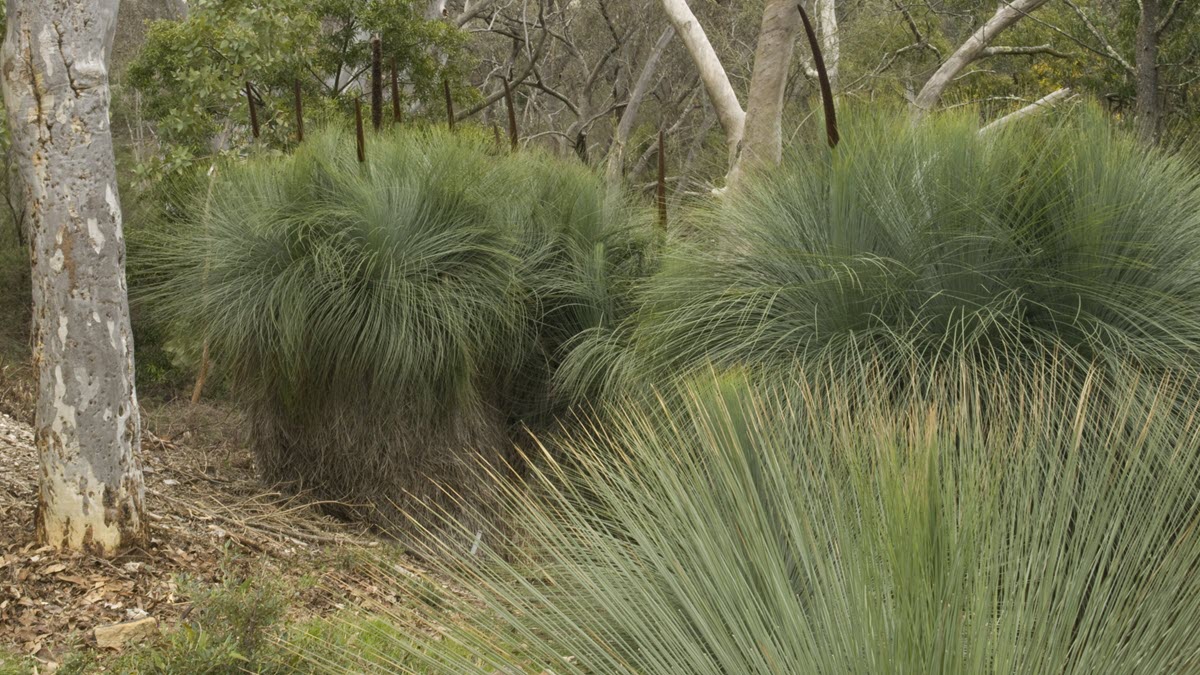

Hi Rara,
I have collected about 20 seeds from a grass tree in my front yard. This article has some good info in it to help me grow my own. Thank you.
As an interesting side note, my wife and I travelled the great centre road. Near the WA/NT border (Docker River) was a stand of about 100 to 150 grass trees, in the lee of a small set of hills. We only spotted them by accident as they are a few hundred metres off the main track. I guess enough rain falls once or twice a year to sustain them, especially if there is good run-off from the small hills.
Thanks Gary
Sounds like a great spot to find grass trees!
Thank you for this most informative article. I have just harvested about 200 seeds from my xanthorrhoea and I have been wondering how to go about starting them. I have started bromeliad seeds in the same manner you suggest. My dining table makes a perfect nursery all year round and the take away containers are a very clean and tidy way to go.
Thanks Carolyn!
Wow, great harvest from one plant. It has been an amazing season of regeneration in eastern Australia. The fires and smoke followed by lots of rain have promoted flowering and seed setting.
Good luck with the germination!
Thank you so much for this very informative article, Rara. I have so enjoyed watching my grass trees grow over the years… in the many gardens I have had… but I had never learned about the progression of the flower spike, until just recently, thanks to you. This time, I collected the seed, planted 24 seeds three weeks ago and now this morning I have 5 tiny shoots that have just made an appearance! So exciting! I am so looking forward to watching them develop and grow. The plant I took the seed from was one I bought a year or so ago from a nursery, so was obviously in a pot when I bought it. However, I planted in my garden when I got it, but I was wondering… to keep some of my babies in pots, is there anything special I should do to successfully be able to do this?
Thanks Lynette
How wonderful! If you wait a while longer, more seedlings will probably pop up 🙂
To keep grass trees in pots, give them a good potting mix, and twice a year (start of spring and autumn) a teaspoon of slow-release fertiliser for native plants. Place the pots in a location where they have full sun during part of the day. Water as needed, but be careful not to over-water.
As they dislike root disturbance, keep re-potting to a minimum.
When you want to put them in a larger pot:
– fill the new pot with potting mix and make a hole that is at least twice as big as the pot they were in
– remove the plant from its old pot, taking care not to disturb the roots too much
– place the plant and its soil in the hole you have made and fill up the remaining space with extra potting mix
– water the new pot with a seaweed solution.
Plants in pots need a bit more TLC than those in the garden, as pots in full sun can dry out quickly. So keep that in mind. However, grass trees (even in pots) are very drought hardy. I found this out by accident when my automated watering system broke down while we were away for two weeks. The pots had completely dried out when we came back, but the grass trees did not suffer.
Yes Rara… even since this morning 4 more have appeared. I am dying to see the germination % compared to seeds planted! I am aiming for 100%, but know that this is probably not practical. 😊 I have individually planted each one of my seeds into its own “cell” … a mini greenhouse styled unit that I bought from Bunnings, so they won’t have to be potted out for a while yet… I hope.
Thankyou so much for the info on growing my little seedlings in pots down the track. Such knowledgeable advice is just so very much appreciated.
Fantastic! Such TLC is great to get them started. Once they are a few months old they will be able to do quite well without cover.
Thank you so much for this info. My xanthorrhoea produced a beautiful flower spike last summer n I understood germination of seeds can take ages.
I have also just received 3 in tube stock that I want to plant out. I was totally bewildered as to what to do next. This article has been wonderful n I feel I can move forward with confidence. Thank you
That’s great! Thanks Lorraine 🙂
This is an absolute gem of a page.
I have sprouted some 2 dozen seedlings in trays from seeds collected down south coast way. I think I have a 75% success rate using cactus mix with added river sand. It was covered by a glass pane taken from a shower set up – fitting perfectly. It’s taken about 3 months – I was about to recycle the soil for a shot at germinating some yuccas when i noticed these singular stalks sprouting in an orderly fashion – planted in linear lines by my wife and I. Boy, is that a good feeling.
Will be transplanting according to the advice found here.
I’m 65 this year and look forward to seeing these plants in my garden in 15 years time.
Keep it green good people.
Thanks to writer(s) of this article!!!!!!!!!!!!!!!!!!!!
What a great result, Kae!
Indeed, the seeds can take a while before they sprout. However, like you, I have always had good germination rates from my experiments.
Very satisfying 🙂
Have collected seeds here in Darwin.
Have got them germinated and have been up about 10-14 days.
Now I wait to repot and pray all goes well.
Thanks for all the tips and info.
Hi Jeff
Sounds like you had great success.
Keep us up to date how they grow 🙂
Great info. Unfortunately i haven’t been able to find any help with my issue.
Have discoverd quite a few self-seeded babies growing near the ancient one out the front of the place I’ve just bought in SE QLD.
It is not the best place for growing them as its clay soil not far down & the massive floods of the recent past & present likely to come more often..
And now the garden around them has been opened up & disturbed including cats digging around them & using soil as a toilet.
Should I transplant them into pots? If so? Is there anything special I need to know or do? I have thought of influding localised soil & broken down plant material to encourage the right microbes & fungi.
Much apprecisted.
If the ecosystem of the garden hadn’t just been
Hello Eleanor
Lucky you to have a self-seeding grass tree!
I think transplanting the seedings will be the best option, either into a pot or to a better location in the garden. Depending on how old the seedlings are, you will need to make sure that when you try to dig up a seedling you dig up as much of the root system as you can.
This is what I would do:
– water the seedling for a few days to make sure the soil around it is easy to dig into
– with a deep spade, dig around the seedling so you can lift the seedling out with its surrounding soil
– try to dig as deep as the leaves are long (for example if the leaf length is 20 cm, try to dig down to 20 cm)
– lift the clump of soil out with the seedling in the middle
– gently crumble off soil from the edges until the clump of soil around the seedling will fit into a larger pot (but if you see roots, stop removing soil on that side), pot up and add potting mix as needed to fill the pot
– water in well with some seaweed fertiliser to stimulate root growth
– grow the seedling in a pot and look after it until its roots are growing through the drainage holes at the bottom of the pot
– plant out the seedling in a new location in the garden (or, if the roots were already longer than the pot when you dug up the seedling, just transplant the seedling directly into another location in your garden) and look after it as discussed above.
Happy planting! Do let us know if you were successful in this transplanting operation.
Just as an aside, have just noticed that my grass tree in a pot has a spike . It is amazing how fast this spike is growing. When I first noticed it it was about 100mm high now after just 6 days it is 340mm high. I was so surprised that I began to measure it each day at the same time and on average it grows about 40mm each day. I found your information on growing from seed very interesting and hopefully may have the opportunity to try this myself when my fast growing spike is finished flowering..
Hi Robert
Fantastic to have a newly developing spike. I always find it very exciting. Yes, they grow very fast. Great that you have actually made some measurements! I will add this to the article 🙂
You’ll have to be more patient before you get some seed though. It takes a while. Remember to wait until the fruit opens up spontaneously on the spike. Meanwhile, enjoy the new flowering spike development.
About 7 years ago my laye cousin brought a 30cm plant from Brisbane. Stuck it in the garden and is now ready to flower. During the last of winter I separated what I thought was the second tree growing under the leaves of the first. Planted it in another place of the garden and it is now sending up new leaves. Must say that I treated all the exposed and cut roots with fungicide befote transplanting.
Very good essay you wrote on this plant. Well done.
I am sure I am the only one in South Africa with two Xanthorrhoea, Grass trees.
From Godwin.
bgrsymons@hotmail.com
Thanks Godwin
That is quite amazing. Not sure if I would have risked what you did, but it is great both plants are growing.
Good luck with it and I hope you get some flowering spikes.
Sometimes ignorance is bliss. Plant still doing well. These are a plant species that really get into the heart.
Godwin.
bgrsymons@hotmail.com
In Mid 2018 my massive grass tree ( trunk circumference 120cm @ today) produced a huge spike for the first time that I saw, I estimate 4-5 metres long. The local wildlife & insects did enjoy the flower so my hopes of making a spear were dashed. We now have 4 crowns & I look forward to the season that produces more spikes. Back in 2005 my mum had it in a pot when the trunk was no bigger than a rugby ball. I took note of the environment that the grass trees were growing wild along Terry’s Creek Eastwood/Epping in Sydney so tried to replicate by nestling it up against a couple of sandstone slabs in the ground, I think I did a good job. I salvaged hundreds of seeds & have them in a jar in the fridge. I did try to germinate some seeds back in summer 2018/2019 but nothing sprung up although I probably didn’t set it up properly. Do you know what the life expectancy of the seeds is?
Also, I was curious to know why it produced a spike that year in 2018. I did notice that it was a particularly dry year so thought that may be the reason. I haven’t watered the tree for more than 12 years.
After finding this website, I have the motivation to try germination again again.
PS – I presume everyone has cut themselves on the super sharp leaves. I even scratched the cornea of my eye on a leaf once & had to go to hospital. Still love the plant though.
Hi Grant
It sounds like you have been very succesful in making your plant thrive. Congratulations!
I have not found much information on seed longivity or viability for grass trees. Keeping the seed in the fridge was a very good idea to extend viability, as this is what seed banks do as well.
Personally, I have not had much problems with germination, but I do know germination time can vary depending on the species. I would just give it another go and see what happens.
Flowering can be induced by various conditions. Fire or smoke is one of these, but so is is stress. So, perhaps drought stress could have been the reason why it flowered in 2018?
Yes, the leaves can be sharp and springy. Best not to cuddle a grass tree 😉
Thank you so much for your excellent (and easy to follow) instructions on germinating Xanthorrhoea from seeds. I harvested about 500 from a flower spike, then planted about 40 seeds and now have 25 seedlings with more appearing!
I used soil from the area where the mother plant was and I think that helped ensure they had the correct nutrients. This certainly gave me a great interest and focus during lockdown!
Thanks Tina
A great idea to use soil from around the mother plant.
I’m so pleased you have been very successful.
You’ll need a big back yard for all those new plants!
Hi again Rara,
Thought I’d let you know I now have about 70 or so shoots ranging from 1cm to 6cms in height. Needless to say several friends have expressed interest in receiving one or two but I have to point out that we’ll be about 90 years old by the time they’re a decent size. Maybe I’ll have a market stall in the year 2040.
Hello Tina
I am absolutely delighted at your germination success! Congratulations.
It will not be that long before you have a decent size grass tree! At 10 years they already look great, even though they will not have a trunk. I have this year planted out several 2-year-old seedlings into the garden. These are tiny plants aboveground (they have between 5 and 10 leaves), but have well developed roots. The only issue with planting out this early is that you do need to place a few stones around the plants so you know where they are in the garden. So, pot up your seedlings and watch them grow 🙂
Thank You for the wonderful article on propagating grass trees from seed. Will it be okay to start the seeds in March if I keep them in the shade in a cool spot?? I’m so excited to try this I can’t wait until autumn!!
I purchased a grass tree from a Nursery about two years ago. This year it did produce a spike that grew up to about 6 inches.
Thanks Mark,
Great you found the article useful and it has pushed you into experimenting 🙂
Seeds germinate at the conditions they like. If it is too hot, they may just take a bit longer. So, I cannot see a problem in trying to germinate them now, if you can keep them away from very hot conditions. Just remember to monitor moisture levels every day so seeds (and seedlings) do not dry out. Let us know how you go!
I’ve come in from pulling dead flower stems from a very stong garlic smelling verigated small strappy plant and noticed these long green stems like from a grass tree that we have in the garden it has three heads and each year we get very long spikes on each head. Now not sure what to do. Should I leave them or risk moving them? Any advice would be very helpful.
Thanks
Hi Karen
If you are asking if you can remove heads from a grass tree, I would advise against it as it would likely kill the whole pant. However, you can trim the leaves to the base. I hope that answers your question.
In 2018 I bought X. australis seeds when I visited Sydney. When I came back to Sweden, I planted them and I have now 6 lovely young Grass Trees in pots in our house.
Last summer I let them be outside for a 4-5 months and they seemed to love it.
My problem is that they take a lot of space where they are placed today. Can I plant them outside and have them there all year around? I live on the west cost of Sweden, so the winter is not that bad. But it can go down to -20°C a couple of days every winter. And we can have snow for 1-4 weeks.
How much cold can they take? Maybe I can cover them for the winter in some way. Are the leaves also sensitive for cold or is it mostly the roots?
We are planning to build a greenhouse. It will not be 100% frost proof but there will be no snow and a bit more stabile and warmer climate. Is that a better place?
Hello Sören
How lovely to hear from someone growing grass trees in Sweden!
Xanthorrhoea australis is quite cold hardy, but I would not dare to say that it will cope with daytime temperatures of -20°C. That is very cold.
Here in Canberra we get to -7°C during the night during the coldest period of winter, but daytime temperatures are mostly above zero. X. australis copes very well in Canberra’s cold. It also grows at higher altitudes in Namadgi National Park where it can get even colder. So, I suspect they can tolerate quite a bit of cold. However, I do not have experience growing grass trees in such low temperatures as you get in Sweden.
I am sure you can keep them outside during the warmer months in Sweden, but I would still suggest placing them in a protected area or — as you suggest — in a glasshouse over winter. I hope this bit of information helps you to make a decision on what to do.
Great article, Many thanks
I have germinated some grass trees in Perth WA. They are about a year old and only have a few (4-5) leaves, some of which are browning off from the tips back. Other than that they seem healthy enough. Is this over/under watering?
Hello Phil
Browning off on the leaf tips is most likely caused by a lack of water. Also, if your young plants are in small pots they will be more sensitive to variable watering conditions. So, to avoid this sensitivity it is best to give them a larger pot at that stage and make sure to water them regularly.
Hello again Rara,
Here we are in late July 2022 and my original group of 140 has now dwindled to 45. Last November I noticed that you said you had just planted out 2 year-old seedlings. My seedlings, though only just under a year old, are between 7cms and 15cms long. I’m not sure about how the roots are going but they’re not protruding from the pots. I’m tempted to transplant a couple of the more mature ones. If I do this should I wait till spring? Or should I just keep them in pots for a while longer?
Regards
Tina
Very nice to hear from you again, Tina!
Great that you have 45 seedlings. Yes, spring is a good time to plant out.
If you think the seedling’s root system is strong and healthy, it should be fine to plant seedlings at one year.
My main reason for waiting until seedlings were 2 years old was to make sure the plants would be visible in the garden and not get lost among the other plants. I can now report that all of those seedlings have doubled in size and leaf numbers and are going strong in the garden. I was a bit worried they would be affected by all the rain we have been getting, but they have thrived. And this in quite a heavy loam/clay soil. So, I would suggest to do some test planting this spring once the danger of frost has passed, and let us know the results 🙂
Thanks Rara, will do!😁
Regards
Tina
Hello. Im hoping that you might be able to help me to understand how I would go about germinating some Red Flowering gum tree seeds, and any other information that you might be able to provide on what climate these trees will and will not survive in.
Any information would be highly appreciated.
Thank you
Hello Norman
The Red Flowering Gum (I assume you are talking about Corymbia ficifolia) is a eucalyptus species from the far south-west of Western Australia.
It can be propagated from seed directly in pots as follows:
– fill planting pots with moist sandy soil
– wet the soil thoroughly and compress
– place one seed flat on its side in each pot and cover lightly with soil
– place the pots in a warm, shaded position and keep moist during germination
Germination usually takes about one to three weeks. You can plant the trees when they are about 20 cm tall. Water when needed in the first year.
The plants like a temperate climate with low summer rainfall and humidity. It is quite drought hardy once established. I know it can be grown in our Canberra region, but it definitely needs protection from heavy frosts (at least when it is establishing). So I would not recommend it for outdoors in regions that have daytime frosts (Canberra only has frost at night).
However, if your climate is too cold, you may be able to grow it indoors in a large pot where you can control the climate.
Thank You Rara for responding so quickly. These seeds will be planted in eastern Canadian conditions, where the summers are hot and the winters are cold. Given that information, could this challenge be treated as a Bonsai tree, and keep inside where it stands a much better chance of survival. These seeds are also from a Tasmanian species.
Thanks
Norman
Hello Norman
Yes, you could keep the tree indoors and use a Bonsai technique to keep it small. All native eucalypts in Tasmania have white flowers, so this seed likely came from an introduced species in Tasmania. Red-flowering gums have been planted all over Australia. If you have its scientific name that may give you a better base to search online and find out how resilient the species is likely to be.
Good luck!
Hi … I have 2 very large grass trees in my front garden. They were in pots when we bought the house and were only about 60 cms across in the 10 years they have now about a 2+m spread. We had a friend come round and she asked if they had flowered and to make them flower try putting a couple of smallish stones down the middle. we did that on one of them and within no time at all it flowered while the other one still hasn’t. The spike is about 12cm in diameter and 3+metres tall. In relation to Norman germinating Eucalypts, they may not germinate like a normal seed as they usually lay dormant until a fire come across the land. The sudden increase in temperature cracks the seed coating so they germinate. Thus the sudden bloom of small eucalypts you see happen after a bushfire. We used to use very fine sandpaper to reduce the thickness of the seed coating to help them germinate when I worked in Agronomy at U.N.E.. The glasshouse manager used to germinate all the trees for the ground staff. Cheers Steve
Hi Steve
That is very interesting! I have never tried this method to make a grass tree flower. Worth a try!
I also have not found that my seeds show a dormancy, but that may well be the case for seed that has been in the bush for a while. I have uswed the sandpaper methoid on other seeds with a hard coat and it works quite well. Thanks for the info!
G DAY
THANKS FOR YOUR ADVICE I COULD NOT FIND A SEED SPIKE IN THE WILD SO I PURCHSED SEED IN PACKED FORM FROM BUNNINGS ROCKHAMPTON I FOLLOWED YOUR GERMANATION METHOD AND A SUCCESS RATE OFF FIFTY PERCENT THAT I AM HAPPY WITH YOU HAVE MADE THIS OLD BLOKE PRETTY PLEASED REGARDS JOHN RITTER
That’s wonderful John
Hope you get some nice plants out of those seedlings!
Hi
Could I please request some interest information about ‘Xanthorrhoea’
After “prick out the seedlings from the seedling tray
Plant each seedling in its own root-training pot using a well-draining potting mix.”
How deep do these new plant get planted?
Is it only the green part is showing above the soil?
Some of my Xanthorrhoea have been potted up and a bit of yellow of stem it showing and they look floppy. Do they need to planted deeper.
Thanks for your help
Hello Maggie
Yes, it is best that the white/yello area (the root) is completely covered by soil when you plant the seedlings. Even if a bit of the green shoot is covered with soil, the seedling will be fine. Also make sure the root is not twisted when you plant your seedling.
I hope you get some nice plants out of your seedlings!
Hi Rara, thank you for your very informative article. I have 3 grass trees, all appear to be the same variety. The biggest one, about 2m wide, produced a huge 4+ metre flower stalk over a year ago and the stalk is still there – it’s still quite solid and strong even though its colour has turned to brown/yellow. My question is how long does it take for a flower stalk to naturally fall off? I also haven’t noticed any seed pods. Can you also shed some light please on how long this process of flowering, to stalk falling, to collecting seed is? Thank you.
Thanks Katarina
The flower stalk can remain on the plant for quite a long time. After flowering, it takes a number of months for the fruits to ripen on the stalk. The dried flowers with fruits that will hold seed will slowly become larger than the surrounding flowers and you will see the fruits in them stick out from the surface. Then it takes another few months before the fruits split open and the seed is ripe and can be harvested. I usually wait until I see the parrots come to peck at the seed to start harvesting myself. I think the time from flowering to harvesting is about 6 months for the plants I have, but this will probably differ by species. Also, not all seed ripens at the same time, so you may find that there is still seed in the open fruits after a year.
I do like the look of the flower spears so I usually just let them drop naturally. It is often the birds that land on the spear that finally crack the base off. It is a great process but requires some patience 🙂
Wonderful article and source of info! Cheers for all the work put into this.
Just wanted to mention that there’s a truly spectacular grass tree garden the last couple of km’s of the trail from Ryan’s Den to Devil’s Kitchen on the Great Ocean Walk, Victoria. It goes on and on with thousands of trees. Make sure to use the brushes and solution provided for your boots each end of the boardwalk to protect the trees from the spread of Cinnamon Fungus.
Hi Gavan
Thanks for your contribution; great info!
Hi, bought 2 glauca grass trees from Australia about 15 years ago they’ve been in the garden ever since but have a clear canopy over them, they are both very tall now and reaching the canopy roof, I live in Wales UK one grass tree has now 2 shoots coming off the base of the grass tree is it possible to remove them and if so how because I would like to try to grow them on if this is possible. Also if I remove the canopy will they survive my climate here in the south of the UK. The weather here has plenty of rain and also goes down to – 6 every now and again in the winter months. Also is it possible to resite these grass trees now if needed thanks Gary.
Hello Gary
Wow, congratulations on successfully growing grass trees outside in the UK! your microclimate must be very good.
Shoots
The shoots you have coming up at the base of the stem are most likely branching of the stem. I do not think it would be possible for these to be removed and survive, as they would not have any roots. The best way to propagate grass trees is by seed, I’m afraid.
Frost tolerance
Your microclimate may change when you remove the canopy above the grass trees. They have a limited frost tolerance. Here in Canberra the temperature can go down to -7C several times during winter, but only during the night. The days are always above freezing. I think this may be a limit to what grass trees can tolerate, so I think you would be taking a risk if you remove the canopy as this is probably protecting them from severe or long lasting frosts.
Transplanting
Grass trees seem to be very sensitive to root disturbance. Personally, after a few failures, I have not tried again. It is absolutely heart breaking when a grass tree that you have nurtured for ten or more years suddenly dies… That said, mature grass trees are available in nurseries in Australia and have most likely been transplanted from their original sites, so it must be possible. But, unfortunately I cannot advise you how to do this safely.
Good luck and enjoy your great trees. I can recommend growing from seed 🙂
Best webpage ever! My X. preissii that I was given as a 2-leafed seedling over 20 years ago threw up it’s first and absolutely enormous flower spike last year. The bees, butterflies, slugs, ants and birds were all very happy, as was I. I actually kept it in a pot for the first 5 years of its life, until I bought a unit with a garden and it transplanted well thank goodness. (The ones I had bought as somewhat mature specimens all eventually died.)
So, I collected seed from the ginormous spike and about ⅓ sprouted in late spring. However, I have just lost the last, most hardy of the seedlings and am very sad about it, especially as some were meant to be potted gifts for my nieces and nephews when they grow up.
I am about to try again with extra seed that I saved, and will follow your wonderfully detailed instructions.
Oh! Also, the head of my 23-year-old one started dividing itself into 3 immediately after it flowered, like you said yours do (in 2)! And now that it finally has something of a trunk, I am going to give it a prune so I can hopefully see it.
Thanks Brigit
I love hearing everyone’s grass tree stories 🙂
Good luck with your new germination attempt and the haircut!
I got about a 90% success rate of germination using cotton wool and a zip lock bag partially opened within 2 weeks.
Hello Katherine
Thanks for this information. That is quite an impressive germination rate! I will certainly try this.
Hello,
Do you have any information on how to store collected seeds and how long they stay viable for?
Hello Wendy
It is best to use fresh seed; but, stored at room temperature seed can remain viable for a number of years.
I have never had any luck with seed, but that was before I read your article so will try your method. I do have a grass tree that I bought when the main body was only about 5cm high, it was on sale at a hardware store that was closing down. I planted it in its own space and watered it with a teaspoon of brown sugar in water once a month for the first year. It is growing at about 3 cms a year now. I think the sugar feeds the mycorrhizal fungi to get it off to a good start. It is now growing prolifically, with branches starting to grow off the sides. No sign of a flower spike yet, growing too quickly to need to generate seeds? I will try your method of growing seed, and just hoping to see one soon, if I live long enough to see them sprout.
Hello Mike
Sounds like sugar water is a great booster for the grass tree. I have not tried this with my plants.
Flowering can be very irregular on grass trees. Some years they do, other years they don’t. They do respond with flowering after fire and I have heard you can apply smoke water to imitate this and encourage them to flower, but I have not tried it myself.
My plants first flowered at about 10-12 years from being planted in the ground (after germination in pots). If your plant already has a 5 cm trunk, it could well be ready to flower. So, you could try the smoke water? Good luck!
Update on flower spuke. It now has one and is incredibly tall, ove 6feet in the old scale. Just waiting to see what the flowers are lioke.
Thanks Michael!
So nice to hear about this long flower spike!
You will certainly get some visitors on it that will come and feed.
Grass trees are normally regarded as basically, tough dry weather plants. However, years ago some companions and I went to the Great Deviding Range in Qld where very large volumes of water from Gladstone’s Awoonga Dam was being pumped to the range. The water then gravitated down Stag Creek to the Bileola Power Station. The first thing we saw was old mature grass trees growing quite happily in rocky pools of water. So grass trees can be very adaptable and this information will suprise many.
Hi Alec
Thanks for this observation! I have never observed grass trees growing in pools of water. Perhaps it is a condition they can tolerate for a short period?
Hi Rara,
Thank you very much for this write-up including your own experiences. It is very informative. One of the best articles on growing Xanthorrhoea.
I have recently germinated X. preissii and X. australis at around 60% of the seeds, using
Scotts/Osmoscote ‘Seed and Cutting Mix’.
Have transplanted some into small pots back-filled with Scotts/Osmoscote ‘Native Potting Mix’, and will be transplanting the rest in the same way, in a few weeks time.
Question: Can I maintain growing them in pots, i.e. upsizing the pots (while being careful with their roots) as they get larger? Can I maintain them in pots for many years and friends or family continue to look after them in pots, without ever transplanting to ground?
I guess one has to be careful with the roots during re-potting/renewing the potting mix.
Hello Al
Great story! So nice to hear you have had such success.
You can certainly keep the plants in pots if you are good at keeping an eye on its soil moisture, and are careful not to distrub the roots when repotting. Do keep in mind that it is much harder keep the soil conditions in a pot stable. Plants in pots dry out faster than plants in soil, and you will also need to control the nutrients. Because Xanthorrhoeas grow so slow, it could be devastating if you loose a plant before it becomes mature… This is one of the reasons I have opted for planting in soil rather than pots.
Good luck and let us know how you go!